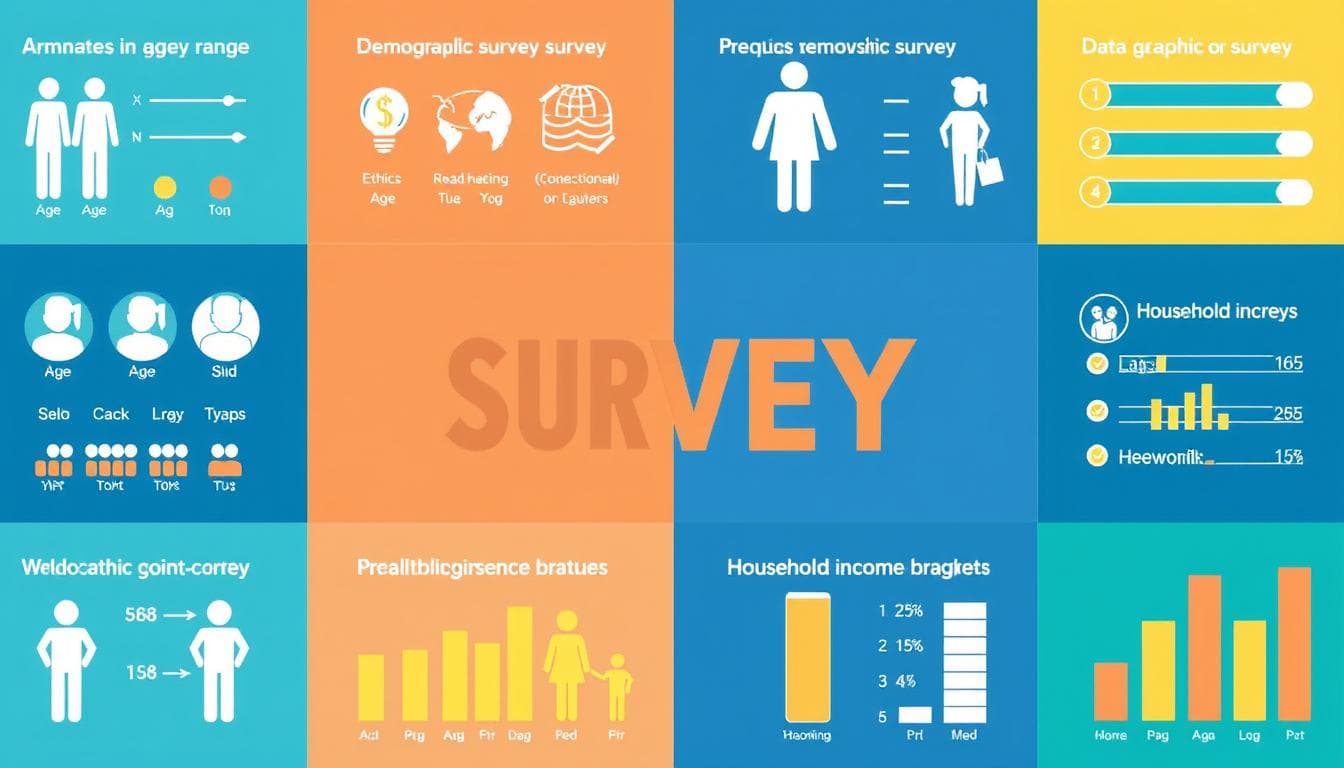Demographic Survey Questions: A Complete Guide
Staff Writer • January 1, 2025 • Uncategorized, marketing, survey

Demographic survey questions are key to understanding your customers. They gather details like age, gender, ethnicity, income, education, and job status. This info helps make accurate buyer personas and spot market trends.
It also ensures your survey results are fair. Common questions include gender identity, age, ethnic background, location, education, marital status, job status, income, and language. It's best to explain the survey's purpose, ask only what's needed, and put demographic questions last.
By grasping the basics of demographic surveys, businesses can use this data wisely. This helps make better decisions, target the right audience, and craft winning marketing plans.
Key Takeaways
- Demographic surveys collect critical data on customer characteristics like age, gender, ethnicity, and income.
- This information helps create accurate buyer personas and identify market trends.
- Common demographic questions cover a range of topics, from gender identity to language preferences.
- Best practices for demographic surveys include explaining the purpose, asking only necessary questions, and placing them at the end of the survey.
- Leveraging demographic data can lead to more informed business decisions, effective targeting, and successful marketing strategies.
Understanding the Fundamentals of Demographic Surveys
Demographic surveys help us understand the diverse makeup of a population. They collect data on age, gender, income brackets, ethnic diversity, household composition, and more. This data is crucial for businesses to make informed decisions about marketing, customer service, and product development.
What Defines a Demographic Survey?
A demographic survey groups a large customer base into smaller groups based on shared traits. By collecting data on age, gender, income, and education level, organizations can better understand their target audience. They can then tailor their offerings to meet those needs.
The Purpose Behind Demographic Data Collection
The main goal of demographic data collection is to uncover insights for strategic decision-making. Businesses use this data to create accurate buyer personas, spot market trends, find new growth opportunities, and ensure fair representation in research and development.
Key Benefits of Demographic Research
Demographic surveys offer many benefits for businesses and organizations. These include:
- Creating detailed buyer personas to understand customer needs and preferences
- Finding market trends and opportunities for innovation
- Ensuring fair representation in research and development
- Improving targeted marketing and advertising campaigns
- Enhancing customer experiences by tailoring products and services
| Demographic Characteristic | Example Survey Questions |
|---|---|
| Age |
|
| Gender |
|
| Ethnic Background |
|
| Household Income |
|
https://www.youtube.com/watch?v=VidKJUu6H8w
Essential Demographic Survey Questions
Creating effective demographic surveys is key to understanding your audience. They cover age, ethnicity, gender identity, marital status, educational qualifications, employment status, and household income. It's important to know what you want to learn, choose the right questions, and offer clear answers.
Demographic surveys often ask about age brackets, race and ethnicity, gender identification, educational qualifications, and marital statuses. Including legally protected groups helps avoid bias and gives a fuller picture. This way, you can see how your policies affect caregivers and how training works for different groups.
It's vital to keep sensitive info private and secure. Tell your employees why it matters and how you'll protect it. Using self-reporting can give you accurate data that's hard to get elsewhere. Using demographic data can make your workplace better and more welcoming for everyone.
- Age ranges
- Gender identity
- Race and ethnicity
- Educational qualifications
- Marital status
- Employment status
- Household income
Conclusion
Demographic surveys are key to understanding different audiences. They help us learn about what people like and need. It's important to make these surveys friendly and not too personal.
Use language that welcomes everyone. Explain why you're asking certain questions. And make sure their answers are safe.
Putting demographic questions at the end can help. This way, people won't feel pressured to answer in a certain way. Stereotype threat can affect answers.
When asking about race, ethnicity, gender, and more, be careful. Offer many choices and list them in alphabetical order. This helps avoid bias.
Demographic surveys are vital for learning about your audience. They help you understand who they are and what they want. This information lets you create better experiences and grow your business.
By using this data, you can make your products and services more appealing. This leads to better targeting and growth. It's all about understanding your audience better.
FAQ
What are demographic survey questions?
Demographic survey questions help understand your customers. They ask about age, gender, ethnicity, income, education, and job status. This info helps make accurate buyer personas and spot market trends.
What is the purpose of demographic data collection?
Demographic surveys aim to improve marketing, customer service, and product development. They help create accurate buyer personas and spot trends. They also reveal new opportunities and ensure fair research representation.
What are the essential demographic survey questions?
Important questions cover age, gender, ethnicity, location, education, and job status. They also ask about income, political views, family, primary language, and religion. When asking sensitive questions, provide context and ensure anonymity. Include options for respondents to skip or select "prefer not to disclose."
What are best practices for designing demographic surveys?
Explain the survey's purpose and only ask necessary questions. Place demographic questions at the end. Offer multiple-choice options with an "Other (please specify)" field for self-identification.
Balance inclusivity with privacy, use inclusive language, and provide reasons for demographic questions. Ensure data security.